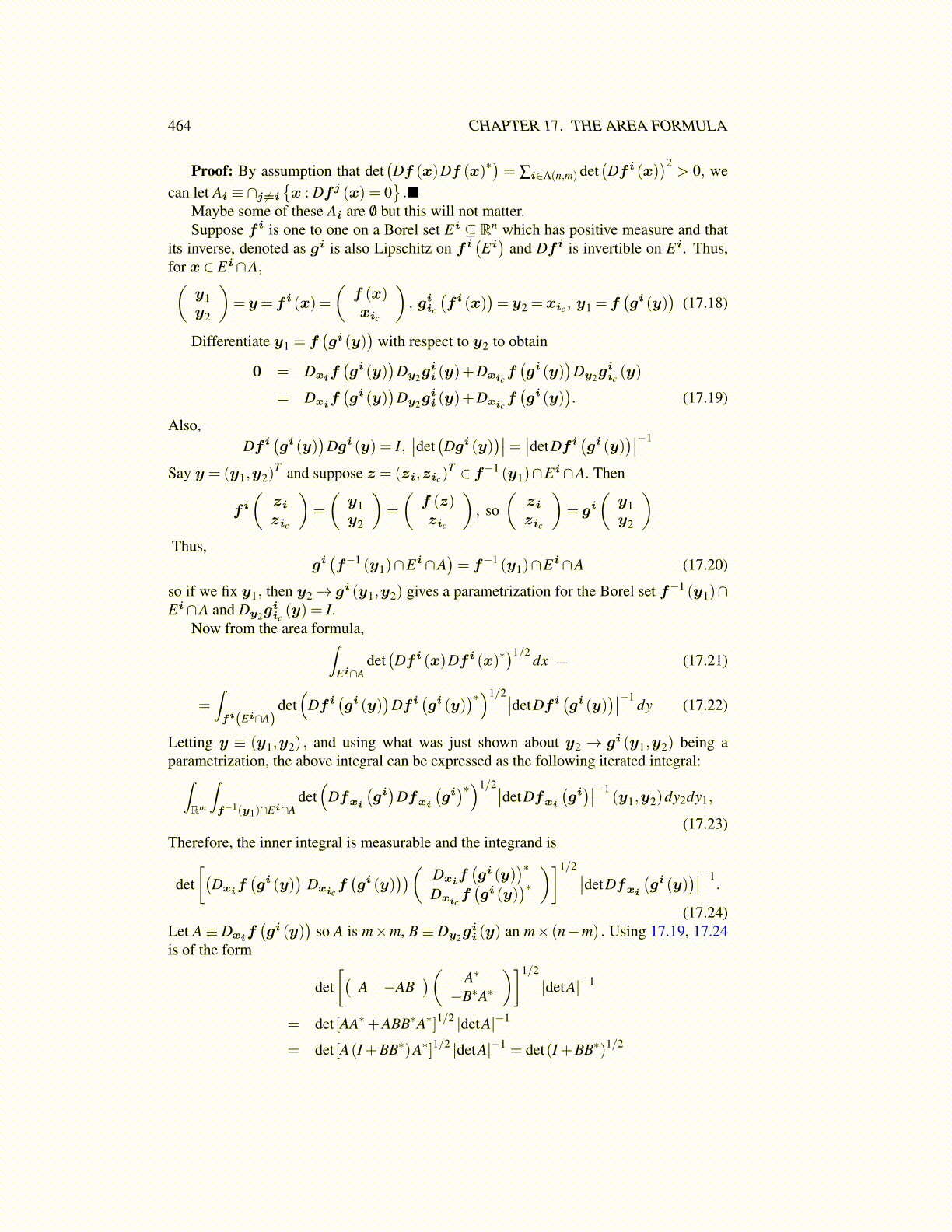
464 CHAPTER 17. THE AREA FORMULA
Proof: By assumption that det(Df (x)Df (x)∗
)= ∑i∈Λ(n,m) det
(Df i (x)
)2> 0, we
can let Ai ≡ ∩j ̸=i
{x : Df j (x) = 0
}.■
Maybe some of these Ai are /0 but this will not matter.Suppose f i is one to one on a Borel set Ei ⊆ Rn which has positive measure and that
its inverse, denoted as gi is also Lipschitz on f i(Ei)
and Df i is invertible on Ei. Thus,for x ∈ Ei∩A,(
y1y2
)= y= f i (x) =
(f (x)xic
), giic
(f i (x)
)= y2 =xic , y1 = f
(gi (y)
)(17.18)
Differentiate y1 = f(gi (y)
)with respect to y2 to obtain
0 = Dxif(gi (y)
)Dy2g
ii (y)+Dxic
f(gi (y)
)Dy2g
iic (y)
= Dxif(gi (y)
)Dy2g
ii (y)+Dxic
f(gi (y)
). (17.19)
Also,Df i
(gi (y)
)Dgi (y) = I,
∣∣det(Dgi (y)
)∣∣= ∣∣detDf i(gi (y)
)∣∣−1
Say y = (y1,y2)T and suppose z = (zi,zic)
T ∈ f−1 (y1)∩Ei∩A. Then
f i
(zizic
)=
(y1y2
)=
(f (z)zic
), so
(zizic
)= gi
(y1y2
)Thus,
gi(f−1 (y1)∩Ei∩A
)= f−1 (y1)∩Ei∩A (17.20)
so if we fix y1, then y2→ gi (y1,y2) gives a parametrization for the Borel set f−1 (y1)∩Ei∩A and Dy2g
iic(y) = I.
Now from the area formula,∫Ei∩A
det(Df i (x)Df i (x)∗
)1/2dx = (17.21)
=∫fi(Ei∩A)
det(
Df i(gi (y)
)Df i
(gi (y)
)∗)1/2∣∣detDf i(gi (y)
)∣∣−1dy (17.22)
Letting y ≡ (y1,y2) , and using what was just shown about y2 → gi (y1,y2) being aparametrization, the above integral can be expressed as the following iterated integral:∫
Rm
∫f−1(y1)∩Ei∩A
det(
Dfxi
(gi)
Dfxi
(gi)∗)1/2∣∣detDfxi
(gi)∣∣−1
(y1,y2)dy2dy1,
(17.23)Therefore, the inner integral is measurable and the integrand is
det[(
Dxif(gi (y)
)Dxic
f(gi (y)
))( Dxif(gi (y)
)∗Dxic
f(gi (y)
)∗ )]1/2 ∣∣detDfxi
(gi (y)
)∣∣−1.
(17.24)Let A≡ Dxi
f(gi (y)
)so A is m×m, B≡ Dy2g
ii (y) an m× (n−m) . Using 17.19, 17.24
is of the form
det[(
A −AB)( A∗
−B∗A∗
)]1/2
|detA|−1
= det [AA∗+ABB∗A∗]1/2 |detA|−1
= det [A(I +BB∗)A∗]1/2 |detA|−1 = det(I +BB∗)1/2